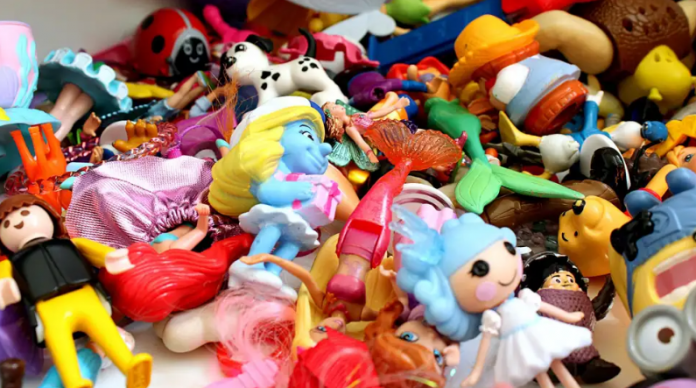If you are a parent, you have at one time or another struggled to get your children to clean up after themselves. There are many methods for instilling better tidying habits in your offspring; from what I call “la-di-da” suggestions, to more “atomic” methods that make waves and get names (and coats, if necessary).
This primer offers a wide range of products. Feel free to choose depending on your mood or level of frustration in your personal journey “to pick up my children’s trash.”
The “take out” and “put away” rule.
This technique teaches children that for every new toy they take out, they must put one away. It also requires a lot of reminders and close supervision of the child while playing, which can immediately make it a difficult transition for some parents (including me). I imagine that the child following this method is cooperative and mild-mannered, and does not have siblings old enough to fight or distract him. But in my home, where these conditions are not present, it would not work.
Set a timer (and turn it into a competition).
Some say you can make cleaning “fun” by setting a timer and asking the child to beat the clock. As a mother of three children who might argue over how to spell “fork,” no thanks; I don’t invite this kind of emotional chaos into my life. In my house, competition leads to crying 100 percent of the time. Some also argue that creating a playlist with your child’s favorite songs can make him or her more willing to respond. You will have to take them at their word.
Make it visual (and be specific)
With this method, everything has its place labeled, so children don’t have to guess where it goes (set a time frame with a specific end time and tell them to put away specific items. Instead of telling them, “Okay, it’s time to clean up,” guide them with simple instructions such as, “First let’s put away all the toy cars” and “Now let’s pick up the red things.” Again, this requires a level of organization and supervision that may not suit everyone.
Make a request and attach a reward or consequence.
We are tempted to formulate what we want in the form of a demand so as not to seem mean or demanding. But when we say, “It’s time to collect, okay?” we leave a lot of room for children to say “no.” Instead, make a non-questioning request, such as, “It’s time to collect,” or “I need you to collect your things now so you won’t have trouble finding something tomorrow.” Remind them of the rewards or consequences you have attached to cleaning, whether it’s extra time for TV or reading, or a day without the things they didn’t put away.
Do it together (and ask if they’d like to donate)
Gentle parenting proponents espouse this method of working together with your child, either by putting your hand over theirs and silently guiding it to the proper place, or picking things up alongside them so they have company. It also normalizes effort through modeling. Or you can calmly ask, “Would you like to put it away or should I put it in the donation bin?”
Tell them how it makes you feel
This article suggests something simultaneously touchy-feely and radical; telling your child how their behavior (not picking up) makes you feel. The concept is that when you let them know how their mess affects you (“I feel sad when I see your stuff lying around like you don’t appreciate it”), it triggers their instinct “to feel connected” and “make other people happy.” It argues that when you kindly convey your disappointment, they’ll be motivated to change their behavior. Hmm. We’re not sure if this is manipulative and guilt-trippy, or honest and effective. You decide.
Now for more drastic measures…
As kids get older, cute games will no longer work. (This is where those atomic methods come into play.) When I asked on TikTok how parents deal with the never-ending mess, the responses ranged from amusing to practical. While responses like: “I usually end up yelling at the top of my lungs” and “I pick it up but throw F bombs while I do” were relatable, they obviously aren’t long-term solutions.
80/20 rule and “Here not there”
One person suggested using the 80/20 rule; where 80% of the time they pick stuff up for their sanity so they have the energy not to pick up the other 20% when they want to teach a lesson (the lesson being pick it up or say goodbye). Another suggested the “Here, not there” philosophy; telling your kids they only have to pick up “here and here” but not “there”— the “there” being reserved for their sibling. This lends itself to everyone thinking they’re getting some kind of break because “there” isn’t their responsibility.
Make them find it (create a “lost and found”)
There are several variations on this technique, which hinges on letting your child experience the natural consequences of not putting away their things. You can either leave things exactly where they left them (which may or may not suit your clutter-and-last-minute-scrambling-tolerance levels) or you can place large plastic bins in areas of greatest offense (or the garage, for extra gravitas). At the end of each day, anything not picked up will be put in that bin; while it will be off the floor, your kids will still have to dig to get what they need.
Pick it up…but charge them
One mom said, “I pick it up, because the principle is that the floor gets cleaned. However, I charge them. Either money or an immediate chore.” Huh. Charging people for the clean-up work we’ve always been expected to give out for free. What a novel concept! (This applies to the bins we just mentioned. Put them high up where they can see—but not reach—their stuff. Tell them they need to clean a toilet to get it back.)
Get it out of your way, but not theirs
One user said, “My mother would block our bedroom doors with the shit we left out that day. She got it out of her way, but never ours.” Several parents echoed this sentiment of placing everything on the child’s bed or floor so while the communal space is ship-shape, they still have their own mess to deal with.
Chuck it
And the most extreme measure of them all…Throwing. It. Out. (Or donating.) When you’ve lost patience with all other methods, give your child a time frame—say, 24 or 48 hours. Let them know if the item is not picked up by then, it will be gone forever. Note: Be sure you’re willing to commit to enforcing this consequence. Are you okay with donating your child’s new winter coat and making them wear a small one from last year if they don’t pick it up? Then, by all means proceed. And enjoy what are hopefully better days of less kid clutter ahead.










